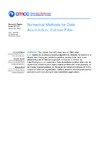The Kalman filter (KF) dates back to 1960, when R. E. Kalman [4] provided a recursive algorithm to compute the solution of a (linear) data filtering and prediction problem, proving to be much more efficient than the N. Wiener’s approach, introduced in 1949 in [5].
Data filtering is a simple example of Data Assimilation problem which can be regarded as a least squares approximation problem and, more precisely, as an inverse ill-posed problem.
In this paper we review and discuss KF in the context of numerical regularization methods aimed to solve ill-posed inverse problems such those arising in Data Assimilation applications.


